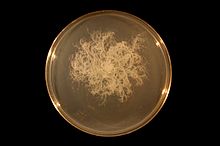Nate
Harmless

Posts: 43
Registered: 2-3-2018
Member Is Offline
Mood: No Mood
|
|
Using B. Substilis and B. Mycoides to increase plant growth
Hello,
For a project at my school I decided to make an aeroponics system. If you don't already know, aeroponics uses a mist of some sort of nutrient
solution to grow plants (basically hydroponics but less water and more air). While I was procrastinating on building it, I started looking more into
plant growth in general, and at the same time got more and more interested in microbiology. I eventually found that Bacillus Substilis and Bacillus
Mycoides are common soil bacteria that can help increase the growth of plants and defend against pathogens. I just wanted to know how I could
inoculate the soil with these 2 isolated bacteria to help increase the growth of my plants.
Here are some of my sources:
https://onlinelibrary.wiley.com/doi/epdf/10.1111/1462-2920.1...
https://www.ncbi.nlm.nih.gov/pubmed/30051589
If you want more you can look up "Bacillus mycoides interaction with plant growth".
|
|
|
Carbon8
Harmless

Posts: 34
Registered: 1-1-2018
Member Is Offline
Mood: No Mood
|
|
Here's a paper that discusses the interactions of plants with various species of Bacillus. The PDF can be downloaded from the link. On page 508 of the
PDF is a list of commercially available Bacillus-based soil additives. If you contact one of the listed companies, they might be willing to send you a
sample of their product with instructions on how to use it.
Interactions of Bacillus spp. and plants
https://www.sciencedirect.com/science/article/pii/S094450130...
[Edited on 15-2-2019 by Carbon8]
|
|
|
Tsjerk
International Hazard
    
Posts: 3022
Registered: 20-4-2005
Location: Netherlands
Member Is Offline
Mood: Mood
|
|
Quote: Originally posted by Nate  | I just wanted to know how I could inoculate the soil with these 2 isolated bacteria to help increase the growth of my plants.
|
You already did, plants are more self-sustaining than people think. If they grow, they have created a microbiome, otherwise, they wouldn't grow.
When I had students isolate microbes from random sources there was never a time I didn't find the two species you mention.
|
|
|
Tsjerk
International Hazard
    
Posts: 3022
Registered: 20-4-2005
Location: Netherlands
Member Is Offline
Mood: Mood
|
|
But if you do want to isolate them, prepare some lb plates, and get some samples from the bottom of your shoes. Identify them by checking them against
pictures from Google.
|
|
|
pneumatician
Hazard to Others
  
Posts: 409
Registered: 27-5-2013
Location: Magonia
Member Is Offline
Mood: ■■■■■■■■■■ INRI ■■■■■■■■■■ ** Igne Natura Renovatur Integra **
|
|
I have some PASSIVE methods to grow much faster plants. With this method you are breaking the equilibrium or moving "energy" from a to b and nothing
more... ummm one example to describe this can be: if one person want sons do not start practicing zoophilia 
well, how about this?: some time ago some marine scientists poured iron into the Pacific ocean to create algae or other organism. The test worked ok,
but after this? Nature do not make springs to end exhauted in a short period of time and start again like a drop in sugar in a diabetic.
Recommendation, work with Nature intelligently.
Now if some company with a good bucked is interested contact me. [End of pedantic mode] 
|
|
|
Metacelsus
International Hazard
    
Posts: 2531
Registered: 26-12-2012
Location: Boston, MA
Member Is Offline
Mood: Double, double, toil and trouble
|
|
Quote: Originally posted by Tsjerk  | | But if you do want to isolate them, prepare some lb plates, and get some samples from the bottom of your shoes. Identify them by checking them against
pictures from Google. |
I would suggest making a slurry of dirt and water, boiling for 10 minutes (to kill all non-spore-forming bacteria), and then plating some of the
supernatant. That's what we did in my undergrad microbiology class. And for identification, we used malachite green staining (and then checking
against pictures).
|
|
|
Tsjerk
International Hazard
    
Posts: 3022
Registered: 20-4-2005
Location: Netherlands
Member Is Offline
Mood: Mood
|
|
Quote: Originally posted by Metacelsus  | Quote: Originally posted by Tsjerk  | | But if you do want to isolate them, prepare some lb plates, and get some samples from the bottom of your shoes. Identify them by checking them against
pictures from Google. |
I would suggest making a slurry of dirt and water, boiling for 10 minutes (to kill all non-spore-forming bacteria), and then plating some of the
supernatant. That's what we did in my undergrad microbiology class. And for identification, we used malachite green staining (and then checking
against pictures). |
Yes that works well if you are going for just the spore forming species, but then you miss all the other nice looking ones!
|
|
|
Nate
Harmless

Posts: 43
Registered: 2-3-2018
Member Is Offline
Mood: No Mood
|
|
Thank you for the replies, I actually already have the culture isolated. I have no idea on either it's bacillus mycoides or bacillus thuringiensis so
more testing is needed.
|
|
|
Tsjerk
International Hazard
    
Posts: 3022
Registered: 20-4-2005
Location: Netherlands
Member Is Offline
Mood: Mood
|
|
Mycoides is easily recognized by its mycoid like growth on plate. If was actually first thought to be a fungus.

|
|
|
ModernCaveman
Harmless

Posts: 3
Registered: 19-1-2020
Member Is Offline
|
|
Definitely curious how this turns out. I'm doing an experiment now on using b. brevis to enhance onion seed germination.
mycoides is my favorite though!
|
|
|